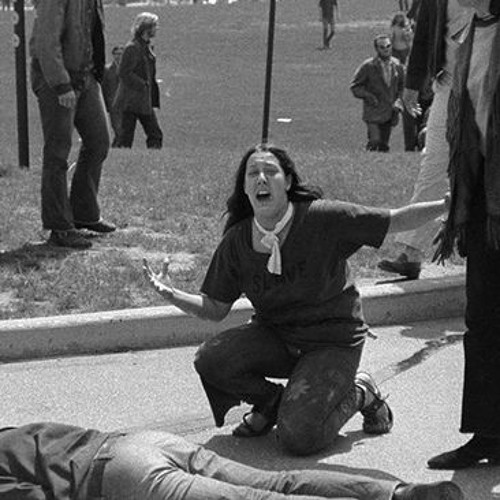In a program first broadcast on the BBC, Four Dead in Ohio tells the story of the Kent State Massacre, May 4th 1970. On that day the National Guard opened fire on several hundred students at Kent State University in northeastern Ohio. Four were killed, nine wounded. Two weeks later, two more students were gunned down at Jackson State in MIssissippi. IN this documentary built around sound recorded at Kent on the day and other sources, and interviews with survivors, Michael Goldfarb tells the story of the killings. he looks at how the event still influences politics and protest in an America as divided now as it was on that day.
Partial transcript of this episode:
“I saw one guy in a gas mask and he made a big movement with his hand and that’s when they fired.”
“I got up and asked her if she was ok and she said Barry I’m hit.”
“The first words out of his mouth were they should have shot all of them.”
“The person who answered it said, Alison was DOA and my mom collapsed.”
To state the facts about Kent State is easy, there were plenty of recordings made on the day. May 4th, 1970 four students at Kent State University, a public institution, in northeastern Ohio were shot dead by the Ohio National Guard during a demonstration against the escalation of the Vietnam war. 9 others were wounded. Those are the facts, these sounds recorded as the event unfolded are closer to the truth of what happened that day, chaos, violence, anger and fear:
Shots being fired.
You mean they are dead? they are dead they have been shot
ambulance sirens
That general told me I have my orders, just like an SS commander he don’t give a fuck if he wipes you out
I know. I’m with you but don’t get killed
I don’t want you kids to die, too many of you kids are too damn good to die in this stinking field here.
Jesus Christ I don’t want to be a part of this
The truth about those days and the weeks and years that followed is what this programme is about. It’s to remind those who were alive then , and more, importantly to tell the story to those who weren’t. Over the decades many would prefer that people forget Kent State. For those who were on the killing field that day, forgetting is a luxury they don’t have.
MG: There were only about 300 protesters in the core group but bystanders, other kids on their way to and from class got sucked in to what was going on. Most ran up and over a hill to get away from the tear gas that had been fired.
The dead were Jeffrey Miller and Allison Krause who were taking part in the demonstration and Sandra Scheuer and William Knox Schroeder, who were simply on their way to class. The victims were all several hundred feet away from the guardsman.
After the ambulances came to take away the dead and the wounded Gerald Casale returned to his dorm. “I think I had a nervous breakdown.
Initial reports from Kent, repeated by the news media, said the Guard had been fired on first, “fake news” which framed many Americans view of what happened.
Nothing comes out of nothing. That spring, The Vietnam war had been going on for years and with it a growing movement of people of all ages against the war. But the young, university students were the front line troops of the anti-war movement. The movement was a powerful new force in an America led by veterans of the good war, World War 2. Anti-war activism helped convince President Lyndon Johnson not to seek re-election in 1968.
Richard Nixon was elected that year on a pledge to end the war and while fewer troops were in the field, the war ground on, and the draft continued, Protest became more organized and widespread, more than a million people had taken part in a series of Marches the previous autumn. The mainstream press was overwhelmingly critical. Nixon felt the sting, “You know you see these bums on the college campuses. These boys are the luckiest people in the world.”
In March 1970, The president dictated a memo to his chief of staff H.R. Haldemann to set up a group in the White House to attack his critics
While Nixon was ordering his attack dogs to bark, American troops were patrolling near the Ho Chi Minh trail on the Vietnam/Cambodia border as documented in a CBS news report at the end of March 1970
On campuses, the division stoked by Nixon’s campaign to paint students as a kind of enemy, worries about the draft, smouldered, and then on Thursday April 30th Nixon ignited the conflagration when he announced an incursion into Cambodia
And within hours, in a world without internet or mobile phones, we all knew this was an invasion, a massive escalation of war that called for a massive escalation of protest.
At Kent State, not far from Cleveland, long simmering town and gown – and biker – tensions about the war – draftees vs draft dodgers – led to violence in a downtown area of bars just off campus, then the building housing the university’s Reserve Officer Training Corps – ROTC – a symbol of the war – was set alight. Ohio’s Republican governor James Rhodes, a staunch Nixon ally, ordered the National Guard to occupy the town and then met the press. “We are going to eradicate the problem, we are not going to treat the symptom!”
